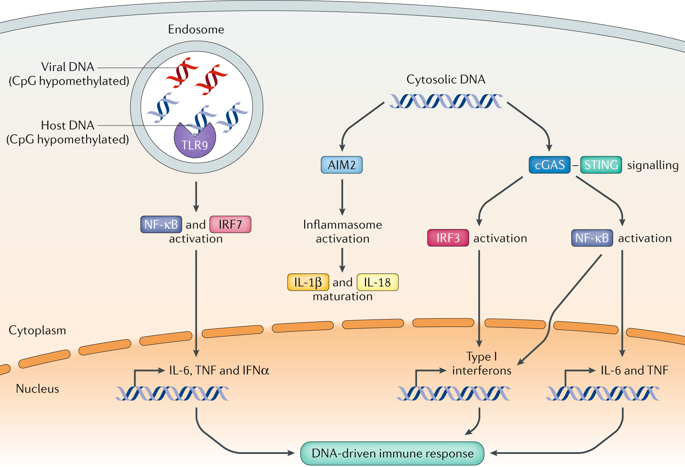当前位置:
X-MOL 学术
›
Nat. Rev. Genet.
›
论文详情
Our official English website, www.x-mol.net, welcomes your
feedback! (Note: you will need to create a separate account there.)
DNA sensing by the cGAS-STING pathway in health and disease.
Nature Reviews Genetics ( IF 39.1 ) Pub Date : 2019-07-29 , DOI: 10.1038/s41576-019-0151-1 Mona Motwani 1 , Scott Pesiridis 2 , Katherine A Fitzgerald 1
Nature Reviews Genetics ( IF 39.1 ) Pub Date : 2019-07-29 , DOI: 10.1038/s41576-019-0151-1 Mona Motwani 1 , Scott Pesiridis 2 , Katherine A Fitzgerald 1
Affiliation

|
The detection of pathogens through nucleic acid sensors is a defining principle of innate immunity. RNA-sensing and DNA-sensing receptors sample subcellular compartments for foreign nucleic acids and, upon recognition, trigger immune signalling pathways for host defence. Over the past decade, our understanding of how the recognition of nucleic acids is coupled to immune gene expression has advanced considerably, particularly for the DNA-sensing receptor cyclic GMP-AMP synthase (cGAS) and its downstream signalling effector stimulator of interferon genes (STING), as well as the molecular components and regulation of this pathway. Moreover, the ability of self-DNA to engage cGAS has emerged as an important mechanism fuelling the development of inflammation and implicating the cGAS-STING pathway in human inflammatory diseases and cancer. This detailed mechanistic and biological understanding is paving the way for the development and clinical application of pharmacological agonists and antagonists in the treatment of chronic inflammation and cancer.
中文翻译:

健康和疾病中 cGAS-STING 通路的 DNA 传感。
通过核酸传感器检测病原体是先天免疫的定义原则。RNA 感应和 DNA 感应受体对外源核酸的亚细胞区室进行采样,并在识别后触发宿主防御的免疫信号通路。在过去的十年中,我们对核酸识别如何与免疫基因表达耦合的理解有了很大进展,特别是对于 DNA 感应受体环 GMP-AMP 合酶 (cGAS) 及其下游的干扰素基因信号效应刺激物 (STING) ),以及该途径的分子成分和调控。此外,自身 DNA 与 cGAS 结合的能力已成为促进炎症发展的重要机制,并暗示 cGAS-STING 途径与人类炎症性疾病和癌症有关。
更新日期:2019-11-18
中文翻译:

健康和疾病中 cGAS-STING 通路的 DNA 传感。
通过核酸传感器检测病原体是先天免疫的定义原则。RNA 感应和 DNA 感应受体对外源核酸的亚细胞区室进行采样,并在识别后触发宿主防御的免疫信号通路。在过去的十年中,我们对核酸识别如何与免疫基因表达耦合的理解有了很大进展,特别是对于 DNA 感应受体环 GMP-AMP 合酶 (cGAS) 及其下游的干扰素基因信号效应刺激物 (STING) ),以及该途径的分子成分和调控。此外,自身 DNA 与 cGAS 结合的能力已成为促进炎症发展的重要机制,并暗示 cGAS-STING 途径与人类炎症性疾病和癌症有关。











































 京公网安备 11010802027423号
京公网安备 11010802027423号